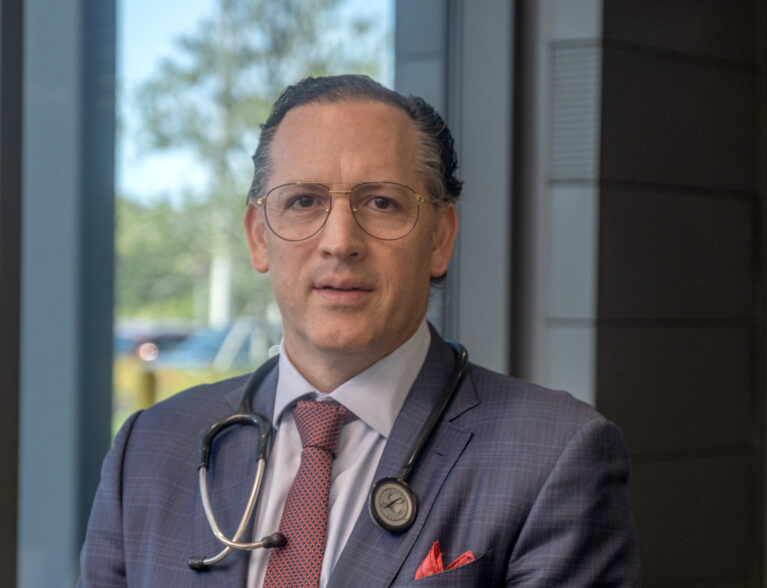
Machinist Richard Bruzzese was up early getting ready to go in to work when he fell to the ground and couldn’t get up. His vision was so impaired that he couldn’t see much of anything, but he was able to crawl to the phone on his nightstand and speed dial his mother, who lived down street. She immediately called an ambulance.
“When the paramedics showed up, I couldn’t see the person in front of me,” Bruzzese recalled. “I wasn’t feeling any pain, but I couldn’t get on my feet. My legs felt like Jell-O.
When I got to the hospital they told me I was very low on blood and would need a transfusion. I didn’t have any lacerations, so where did the blood go? Once they took a stool sample, they determined I was bleeding from my esophagus. The blood was passing into my stomach and coming out in my waste.”
After this alarming news Bruzzese had an endoscopy, which found a tumor in his esophagus.
A positron emission tomography (PET) scan found that the cancer had spread, with two more tumors in his stomach. Radiation was administered to shrink the tumors so surgery could be performed to remove them. The prognosis wasn’t good – he was told that, even with surgery, he would be lucky to live two years.
That was before Dr. Luis Argote-Greene took over the case.
“Esophageal cancer is a very rare disease in the United States with less than 200,000 cases a year, and it’s usually found in an older population,” said Dr. Argote-Greene. “It’s a cancer usually found at the junction between the esophagus [and the stomach]. Ninety percent of the esophagus goes through the chest. Then there’s the G-junction or the gastroesophageal junction that joins the food pipe with the stomach below the diaphragm in the belly.
“The G-junction has a sphincter that dilates and opens up to let the food go by after it’s swallowed through the mouth, goes down into the esophagus through your chest and down into the stomach. This is where this type of cancer usually occurs. As the tumor grows it starts to block the esophagus’ opening and the patient has trouble swallowing.”
Esophageal cancer typically grows very rapidly. The esophagus is very flexible and expands around the tumor as it grows, which is why people often don’t have symptoms until the cancer has spread.
Difficulty swallowing is the first symptom people may notice. Other red flags are pains in your throat or back, behind your breastbone or between your shoulder blades, vomiting or coughing up blood, heartburn, hoarseness or chronic cough, and unintentional weight loss.
While the exact cause of the cancer has yet to be defined, Cleveland Clinic identifies risk factors that increase the chances of esophageal cancer. Tobacco use, alcohol use and obesity are contributing factors, as are Barrett’s esophagus and chronic acid reflux. Barrett’s esophagus is a change in the cells at the lower end of the esophagus that occurs from chronic untreated acid reflux. People with the human papillomavirus (HPV) and those who’ve had cancer of the neck or head are also at greater risk for esophageal cancer.
“I have had trouble swallowing for years,” said Bruzzese. “I was overweight, and I wanted to get in shape, so I started eating a lot of raw carrots for snacks. Apparently, that’s what tore the wall of the tumor and caused the bleeding. If that hadn’t happened, I never would have known.”
“There’s been a lot of advancements in the treatment of esophageal cancer,” Dr. Argote Greene said. “If it’s a very early disease, surgery might be the best option. An endoscopic resection done with a scope might be all that’s needed. But when it’s more advanced like Richard’s, which usually the way we find it, then we treat with chemotherapy and radiation followed by surgery.”
Dr. Argote-Greene used the robotic assisted minimally invasive esophagectomy (RAMIE) to remove the diseased portion of Bruzzese’s esophagus and create a new conduit from the stomach that was connected to the remaining esophagus.
“He actually removed my esophagus and stretched my stomach up to where it connects to my throat,” Bruzzese said. “Now on an X-ray my stomach looks like a wine bottle instead of that weird shape. I was up and walking after three days. I’ve changed my eating habits because I can only fit so much in my stomach now, but I’m doing fine. I’m on immunotherapy and I have a PET scan every now and then, but I am very grateful to be alive. Dr. Argote-Greene and his team saved my life.”
Dr. Argote-Greene is optimistic about Bruzzese’s future. “He had a great response to the treatment, and we’ll continue to monitor him closely.”
Luis M. Argote-Greene, MD, is a thoracic and esophageal surgeon who specializes in complex open and minimally invasive, robotic-assisted procedures to treat benign and malignant diseases in the thoracic area, including esophagus, mediastinum, chest wall, diaphragm, pleura, airways and lung tumors. He earned his medical degree at National Autonomous University of Mexico and completed his residency in General Surgery at the National Institute of Health Sciences and Nutrition Salvador Zubiran in Mexico City. He completed his Thoracic Surgery and Thoracic Oncology Clinical Fellowships at Brigham and Women’s Hospital and Harvard Medical School in Boston. His office is in the Rosner Family Health and Wellness Center at Cleveland Clinic Indian River Hospital. Most patients are referred to surgery after being diagnosed by another doctor. You, or your doctor’s office, can call 772-563-4673 to request an appointment.



